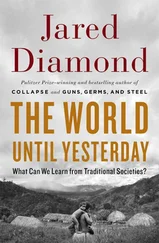Jared Diamond - Guns, Germs & Steel
Здесь есть возможность читать онлайн «Jared Diamond - Guns, Germs & Steel» весь текст электронной книги совершенно бесплатно (целиком полную версию без сокращений). В некоторых случаях можно слушать аудио, скачать через торрент в формате fb2 и присутствует краткое содержание. Жанр: 105. Описание произведения, (предисловие) а так же отзывы посетителей доступны на портале библиотеки ЛибКат.
- Название:Guns, Germs & Steel
- Автор:
- Жанр:
- Год:неизвестен
- ISBN:нет данных
- Рейтинг книги:5 / 5. Голосов: 1
-
Избранное:Добавить в избранное
- Отзывы:
-
Ваша оценка:
- 100
- 1
- 2
- 3
- 4
- 5
Guns, Germs & Steel: краткое содержание, описание и аннотация
Предлагаем к чтению аннотацию, описание, краткое содержание или предисловие (зависит от того, что написал сам автор книги «Guns, Germs & Steel»). Если вы не нашли необходимую информацию о книге — напишите в комментариях, мы постараемся отыскать её.
Guns, Germs & Steel — читать онлайн бесплатно полную книгу (весь текст) целиком
Ниже представлен текст книги, разбитый по страницам. Система сохранения места последней прочитанной страницы, позволяет с удобством читать онлайн бесплатно книгу «Guns, Germs & Steel», без необходимости каждый раз заново искать на чём Вы остановились. Поставьте закладку, и сможете в любой момент перейти на страницу, на которой закончили чтение.
Интервал:
Закладка:
FARMER POWER • 87
Factors Underlying the Broadest Pattern of History
ULTIMATE FACTORS
many domesticated plant and animal species
food surpluses, food storage
large, dense, sedentary, stratified societies
\
PROXIMATE
FACTORS horses guns, ocean– political epidemic
going organization, diseases
ships writing
helped feed dense societies in which epidemics could maintain themselves, and partly because the diseases evolved from germs of the domes tic animals themselves.
88 • GUNS, GERMS,and steel
able calories means more people. Among wild plant and animal species, only a small minority are edible to humans or worth hunting or gathering. Most species are useless to us as food, for one or more of the following reasons: they are indigestible (like bark), poisonous (monarch butterflies and death-cap mushrooms), low in nutritional value (jellyfish), tedious to prepare (very small nuts), difficult to gather (larvae of most insects), or dangerous to hunt (rhinoceroses). Most biomass (living biological matter) on land is in the form of wood and leaves, most of which we cannot digest.
By selecting and growing those few species of plants and animals that we can eat, so that they constitute 90 percent rather than 0.1 percent of the biomass on an acre of land, we obtain far more edible calories per acre. As a result, one acre can feed many more herders and farmers— typically, 10 to 100 times more—than hunter-gatherers. That strength of brute numbers was the first of many military advantages that food-producing tribes gained over hunter-gatherer tribes.
In human societies possessing domestic animals, livestock fed more people in four distinct ways: by furnishing meat, milk, and fertilizer and by pulling plows. First and most directly, domestic animals became the societies' major source of animal protein, replacing wild game. Today, for instance, Americans tend to get most of their animal protein from cows, pigs, sheep, and chickens, with game such as venison just a rare delicacy. In addition, some big domestic mammals served as sources of milk and of milk products such as butter, cheese, and yogurt. Milked mammals include the cow, sheep, goat, horse, reindeer, water buffalo, yak, and Arabian and Bactrian camels. Those mammals thereby yield several times more calories over their lifetime than if they were just slaughtered and consumed as meat.
Big domestic mammals also interacted with domestic plants in two ways to increase crop production. First, as any modern gardener or farmer still knows by experience, crop yields can be greatly increased by manure applied as fertilizer. Even with the modern availability of synthetic fertilizers produced by chemical factories, the major source of crop fertilizer today in most societies is still animal manure—especially of cows, but also of yaks and sheep. Manure has been valuable, too, as a source of fuel for fires in traditional societies.
In addition, the largest domestic mammals interacted with domestic plants to increase food production by pulling plows and thereby making it possible for people to till land that had previously been uneconomical for farming. Those plow animals were the cow, horse, water buffalo, Bali
FARMER POWER • 89
cattle, and yak / cow hybrids. Here is one example of their value: the first prehistoric farmers of central Europe, the so-called Linearbandkeramik culture that arose slightly before 5000 B.C., were initially confined to soils light enough to be tilled by means of hand-held digging sticks. Only over a thousand years later, with the introduction of the ox-drawn plow, were those farmers able to extend cultivation to a much wider range of heavy soils and tough sods. Similarly, Native American farmers of the North American Great Plains grew crops in the river valleys, but farming of the tough sods on the extensive uplands had to await 19th-century Europeans and their animal-drawn plows.
All those are direct ways in which plant and animal domestication led to denser human populations by yielding more food than did the hunter-gatherer lifestyle. A more indirect way involved the consequences of the sedentary lifestyle enforced by food production. People of many hunter-gatherer societies move frequently in search of wild foods, but farmers must remain near their fields and orchards. The resulting fixed abode contributes to denser human populations by permitting a shortened birth interval. A hunter-gatherer mother who is shifting camp can carry only one child, along with her few possessions. She cannot afford to bear her next child until the previous toddler can walk fast enough to keep up with the tribe and not hold it back. In practice, nomadic hunter-gatherers space their children about four years apart by means of lactational amenorrhea, sexual abstinence, infanticide, and abortion. By contrast, sedentary people, unconstrained by problems of carrying young children on treks, can bear and raise as many children as they can feed. The birth interval for many farm peoples is around two years, half that of hunter-gatherers. That higher birthrate of food producers, together with their ability to feed more people per acre, lets them achieve much higher population densities than hunter-gatherers.
A separate consequence of a settled existence is that it permits one to store food surpluses, since storage would be pointless if one didn't remain nearby to guard the stored food. While some nomadic hunter-gatherers may occasionally bag more food than they can consume in a few days, such a bonanza is of little use to them because they cannot protect it. But stored food is essential for feeding non-food-producing specialists, and certainly for supporting whole towns of them. Hence nomadic hunter-gatherer societies have few or no such full-time specialists, who instead first appear in sedentary societies.
Two types of such specialists are kings and bureaucrats. Hunter-gath-
90 • GUNS, GERMS, AND STEEL
erer societies tend to be relatively egalitarian, to lack full-time bureaucrats and hereditary chiefs, and to have small-scale political organization at the level of the band or tribe. That's because all able-bodied hunter-gatherers are obliged to devote much of their time to acquiring food. In contrast, once food can be stockpiled, a political elite can gain control of food produced by others, assert the right of taxation, escape the need to feed itself, and engage full-time in political activities. Hence moderate-sized agricultural societies are often organized in chiefdoms, and kingdoms are confined to large agricultural societies. Those complex political units are much better able to mount a sustained war of conquest than is an egalitarian band of hunters. Some hunter-gatherers in especially rich environments, such as the Pacific Northwest coast of North America and the coast of Ecuador, also developed sedentary societies, food storage, and nascent chiefdoms, but they did not go farther on the road to kingdoms.
A stored food surplus built up by taxation can support other full-time specialists besides kings and bureaucrats. Of most direct relevance to wars of conquest, it can be used to feed professional soldiers. That was the decisive factor in the British Empire's eventual defeat of New Zealand's well-armed indigenous Maori population. While the Maori achieved some stunning temporary victories, they could not maintain an army constantly in the field and were in the end worn down by 18,000 full-time British troops. Stored food can also feed priests, who provide religious justification for wars of conquest; artisans such as metalworkers, who develop swords, guns, and other technologies; and scribes, who preserve far more information than can be remembered accurately.
So far, I've emphasized direct and indirect values of crops and livestock as food. However, they have other uses, such as keeping us warm and providing us with valuable materials. Crops and livestock yield natural fibers for making clothing, blankets, nets, and rope. Most of the major centers of plant domestication evolved not only food crops but also fiber crops—notably cotton, flax (the source of linen), and hemp. Several domestic animals yielded animal fibers—especially wool from sheep, goats, llamas, and alpacas, and silk from silkworms. Bones of domestic animals were important raw materials for artifacts of Neolithic peoples before the development of metallurgy. Cow hides were used to make leather. One of the earliest cultivated plants in many parts of the Americas was grown for nonfood purposes: the bottle gourd, used as a container.
Big domestic mammals further revolutionized human society by becom-
Интервал:
Закладка:
Похожие книги на «Guns, Germs & Steel»
Представляем Вашему вниманию похожие книги на «Guns, Germs & Steel» списком для выбора. Мы отобрали схожую по названию и смыслу литературу в надежде предоставить читателям больше вариантов отыскать новые, интересные, ещё непрочитанные произведения.
Обсуждение, отзывы о книге «Guns, Germs & Steel» и просто собственные мнения читателей. Оставьте ваши комментарии, напишите, что Вы думаете о произведении, его смысле или главных героях. Укажите что конкретно понравилось, а что нет, и почему Вы так считаете.










